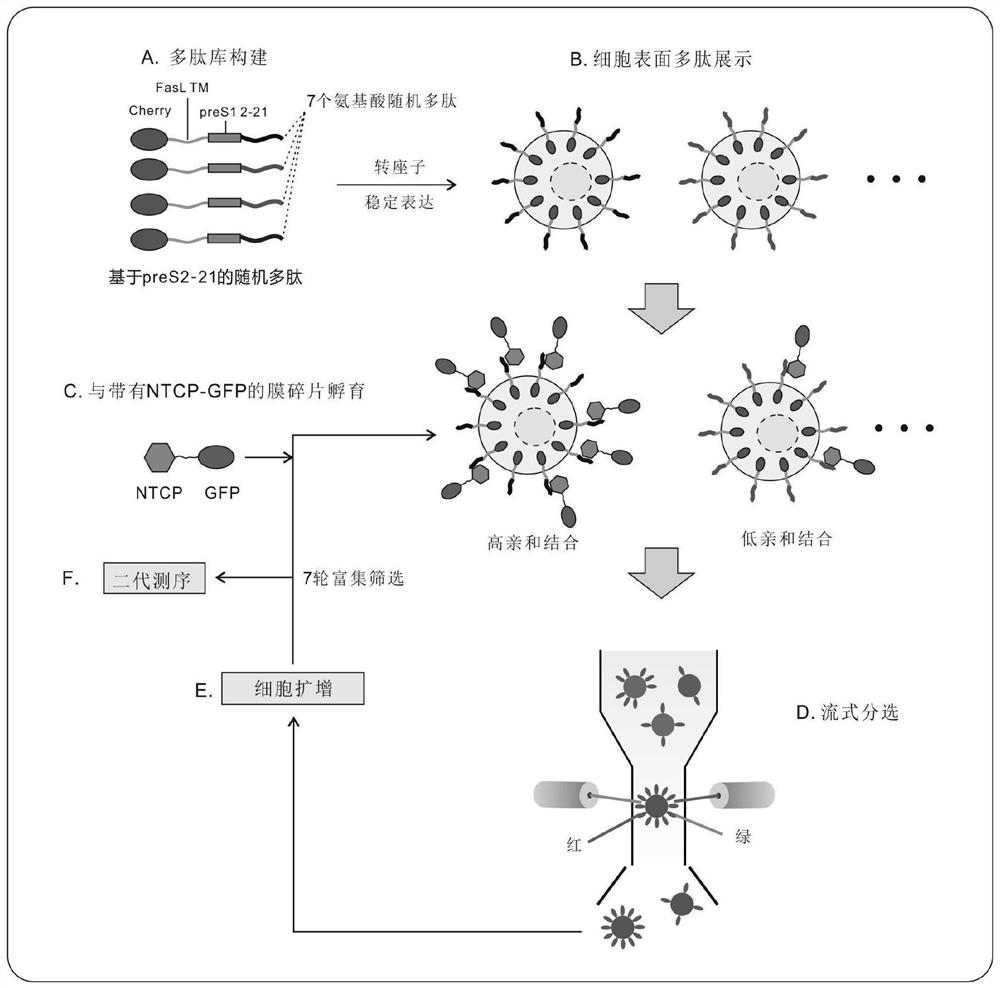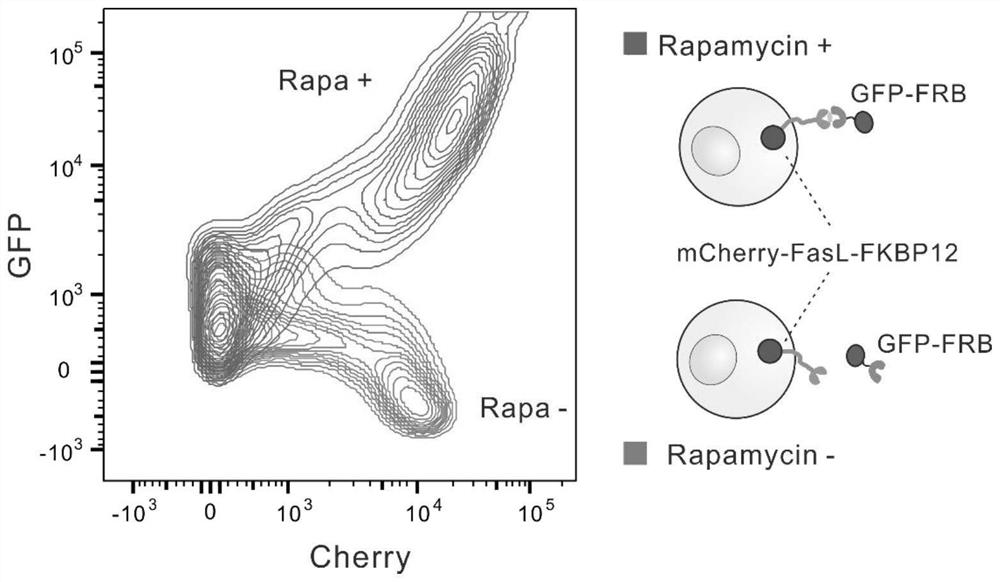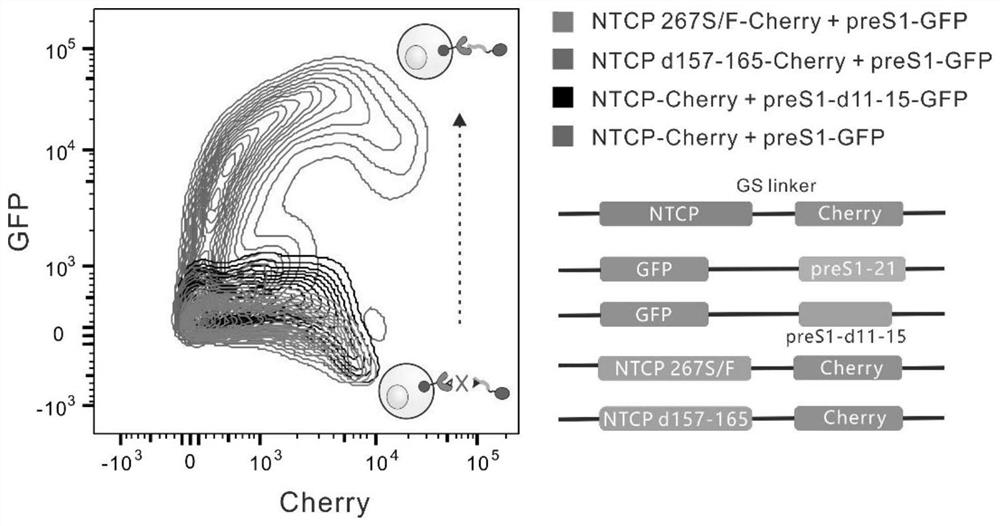Polypeptide based on human cell surface display technology and targeted HBV receptor and application of polypeptide
A surface display and cell technology, applied in the fields of molecular biology and biomedicine, can solve the problems of membrane proteins not forming a functional normal structure, membrane proteins are difficult to express and purify, and cannot be used, so as to improve the anti-HBV infection effect. Effect
- Summary
- Abstract
- Description
- Claims
- Application Information
AI Technical Summary
Problems solved by technology
Method used
Image
Examples
Embodiment 1
[0051] Example 1 Plasmid construction
[0052] Plasmids GFP-FRB, FRB-GFP, Cherry-FasL-FKBP, NTCP-GFP were constructed in the early stage, and other plasmids were constructed on this basis.
[0053] The plasmid GFP-FRB is a plasmid obtained by inserting the green fluorescent protein GFP gene into the expression frame between the CMV promoter and the SV40 terminator with RlucN-HBC as the backbone, wherein GFP is located at the N-terminus and FRB is located at the C-terminus.
[0054] The plasmid FRB-GFP is a plasmid obtained by inserting the green fluorescent protein GFP gene into the expression frame between the CMV promoter and the SV40 terminator with RlucN-HBC as the backbone, wherein FRB is located at the N-terminus and GFP is located at the C-terminus.
[0055] The plasmid Cherry-FasL-FKBP is a plasmid obtained by inserting the fusion gene of red fluorescent protein-FasL-FKBP into the expression frame between the CMV promoter and the SV40 terminator with RlucN-HBC as the b...
Embodiment 2
[0087] Example 2 Feasibility verification of flow sorting and enrichment
[0088] 1. Using the FKBP12-FRB system to verify the feasibility of flow sorting and enrichment
[0089] One of the keys to establishing the screening system in the technical solution of the present invention is that flow cytometry can be used to perform sorting and enrichment, and to isolate those polypeptide-displaying cells that can bind to NTCP. To verify the feasibility of this flow sorting method, we first performed a simulation test using rapamycin to modulate the FKBP12-FRB interaction system.
[0090] The plasmid GFP-FRB was transfected into HEK293 cells. After 48 hours of transfection, the cells were collected by trypsinization and resuspended in PBS, and then the cells were lysed by repeated freezing and thawing in liquid nitrogen and a 37°C water bath. The lysed cell debris was removed by centrifugation, and the supernatant containing the fusion protein GFP-FRB was obtained for use. The pla...
Embodiment 3
[0108] Example 3. Verification of the anti-HBV infection effect of Myr-217-3 in HepG2-NTCP cell model
[0109] The polypeptide 217-3 (N-terminal myristoylation modification) screened in Example 2 and the polypeptide Myr21 as a control were synthesized in vitro. HepG2-NTCP was pretreated with different concentration gradients of polypeptides for 2 hours, and then infected with hepatitis B virus. The medium was changed every 2 days, and the HBeAg and HBsAg in the cell culture supernatant were detected simultaneously on the seventh day. The results show( Figure 10 ), the IC50 of Myr-217-3 (N-terminal myristoylation-modified polypeptide 217-3) in inhibiting HBV infection was improved by about 8 times compared with Myr-21.
PUM
 Login to View More
Login to View More Abstract
Description
Claims
Application Information
 Login to View More
Login to View More - R&D
- Intellectual Property
- Life Sciences
- Materials
- Tech Scout
- Unparalleled Data Quality
- Higher Quality Content
- 60% Fewer Hallucinations
Browse by: Latest US Patents, China's latest patents, Technical Efficacy Thesaurus, Application Domain, Technology Topic, Popular Technical Reports.
© 2025 PatSnap. All rights reserved.Legal|Privacy policy|Modern Slavery Act Transparency Statement|Sitemap|About US| Contact US: help@patsnap.com



